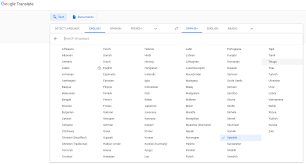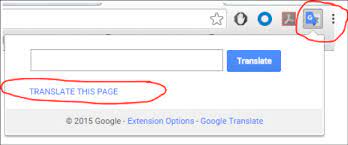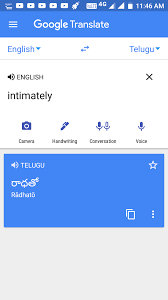Google Translate: The Power to Detect Language
In today’s interconnected world, language barriers can hinder communication and understanding between people from different cultures. Thankfully, technology has come to the rescue, with tools like Google Translate leading the way in breaking down these barriers. One of the most impressive features of Google Translate is its ability to automatically detect the language of a given text. Let’s take a closer look at how this remarkable feature works and why it’s so valuable.
The ability to detect language automatically is a game-changer for anyone using translation services. Whether you’re traveling abroad, conducting business internationally, or simply trying to understand foreign content online, Google Translate’s language detection feature saves you time and effort by eliminating the need to manually specify the source language.
So how does it work? Behind the scenes, Google Translate employs sophisticated machine learning algorithms that analyze various linguistic patterns and characteristics within a text snippet. These algorithms compare the input text against an extensive database of languages and their unique traits. By examining factors such as word frequency, sentence structure, and grammatical rules specific to each language, Google Translate can accurately identify which language is being used.
What makes this feature truly impressive is its accuracy. Google Translate’s language detection capability boasts an impressive success rate due to its continuous improvement through machine learning techniques. As more data is fed into the system and more translations are performed, the algorithms become increasingly refined and capable of accurately identifying even lesser-known languages or dialects.
The benefits of accurate language detection are far-reaching. It streamlines the translation process by automatically selecting the appropriate source language, ensuring that translations are as precise as possible. This feature also enhances user experience by eliminating guesswork or potential errors caused by manual selection.
Moreover, Google Translate’s automatic language detection opens up possibilities for various applications beyond translation itself. For instance, businesses can use this feature to analyze customer feedback or reviews in different languages without needing prior knowledge of those languages. It can also assist researchers in studying multilingual data sets or help individuals understand foreign content in real-time during conferences or presentations.
However, like any technology, Google Translate’s language detection feature does have its limitations. Certain texts with a mixture of languages or unconventional writing styles may pose challenges for accurate identification. Additionally, the system may struggle with low-resource languages that have limited data available for training the algorithms. Nevertheless, Google Translate’s ongoing development and continuous learning ensure that these limitations are gradually being overcome.
In conclusion, Google Translate’s language detection feature is a testament to the power of artificial intelligence and machine learning in overcoming language barriers. By automatically identifying the source language of a given text, this remarkable tool simplifies and enhances the translation process for millions of users worldwide. As technology continues to advance, we can expect even more impressive breakthroughs that bring us closer together, regardless of our native languages.
5 Tips for Accurate Language Detection with Google Translate
- Use the “Detect Language” feature to ensure accuracy when translating a text or document.
- Check the language settings of your device before using Google Translate to detect language.
- Try to use shorter sentences and phrases for better accuracy when detecting language with Google Translate.
- Be aware that Google Translate is not always 100% accurate in detecting the correct language, so double-check your translations if you are unsure about the language used in a text or document.
- If you need help identifying a specific language, try searching online for resources that can help you identify it more accurately than Google Translate can detect it automatically.
Use the “Detect Language” feature to ensure accuracy when translating a text or document.
Use the “Detect Language” Feature for Accurate Translations
When it comes to translating texts or documents using Google Translate, accuracy is key. To ensure the highest level of precision in your translations, it’s essential to make use of the “Detect Language” feature provided by Google Translate.
The “Detect Language” feature is a powerful tool that automatically identifies the source language of a given text. By selecting this option, you allow Google Translate to analyze the text and determine its original language without any manual input required from you.
Why is this feature so important? Well, sometimes we come across texts or documents that are written in languages we may not be familiar with. In such cases, manually selecting the source language can be challenging and may lead to inaccuracies in translation. However, by utilizing the “Detect Language” feature, you can be confident that Google Translate will accurately identify the language and provide a more precise translation.
Using this feature is simple. When entering your text into Google Translate, leave the “From” field blank or select “Detect Language.” Once you input your text, Google Translate will automatically analyze it and determine the appropriate source language. From there, you can select your desired target language for translation.
By relying on the “Detect Language” feature, you eliminate any guesswork and potential errors that can occur when manually selecting a source language. This ensures that your translations are as accurate as possible, allowing for better communication and understanding across different languages and cultures.
Whether you’re working on a business document, academic paper, or simply trying to understand foreign content online, using the “Detect Language” feature in Google Translate provides peace of mind and saves valuable time. It guarantees that your translations start from a reliable foundation before being converted into your desired target language.
In conclusion, when using Google Translate to translate texts or documents, don’t overlook the importance of the “Detect Language” feature. It’s a valuable tool that enhances the accuracy of your translations and helps you overcome language barriers effectively. So, next time you need to translate a text, remember to utilize this feature for the best possible results.
Check the language settings of your device before using Google Translate to detect language.
Optimizing Google Translate’s Language Detection: Check Your Device Settings
When using Google Translate to detect the language of a text, it’s important to ensure that your device’s language settings are correctly configured. This small but crucial step can significantly enhance the accuracy and reliability of Google Translate’s language detection feature.
Language settings on your device play a vital role in determining the default language for various applications, including translation tools like Google Translate. If your device is set to a particular language, it may impact the results provided by Google Translate when attempting to automatically detect the source language.
To optimize your experience with Google Translate’s language detection feature, follow these simple steps:
- Check your device settings: Start by accessing the language settings on your device. This can usually be found in the “Settings” or “Preferences” section, depending on your operating system.
- Set your preferred language: Ensure that the default language setting matches your primary or preferred language. This setting will help Google Translate accurately identify and translate texts from other languages.
- Enable multilingual support: Some devices offer multilingual support, allowing you to select multiple languages as preferences. Enabling this feature can be particularly useful if you frequently encounter texts in different languages.
- Update software and apps: Regularly update both your device’s operating system and the Google Translate application itself. Updates often include improvements and bug fixes that enhance the performance of features like language detection.
By taking these simple steps, you can maximize the effectiveness of Google Translate’s automatic language detection feature and enjoy more accurate translations. It ensures that any text you input into Google Translate is correctly identified for precise translation results.
Remember, even with advanced machine learning algorithms powering automatic language detection, ensuring that your device settings align with your intended usage is essential for optimal performance. By paying attention to these details, you’ll experience smoother translations and a more seamless communication experience across different languages.
So before relying on Google Translate to detect the language of a text, take a moment to review and adjust your device’s language settings. This small effort will go a long way in ensuring accurate and reliable translations, helping you break down language barriers with confidence.
Try to use shorter sentences and phrases for better accuracy when detecting language with Google Translate.
Enhance Language Detection Accuracy with Google Translate: Keep It Short and Simple
When it comes to utilizing Google Translate’s language detection feature, there’s a simple tip that can significantly improve accuracy: try to use shorter sentences and phrases. By keeping your text concise, you enhance the system’s ability to identify the correct source language more effectively.
Google Translate’s language detection feature relies on complex algorithms and linguistic patterns to analyze and identify languages within a given text. While the technology has made impressive strides in accurately detecting languages, providing it with shorter sentences and phrases can help minimize potential confusion or ambiguity.
Shorter texts allow the algorithms to focus on key linguistic characteristics unique to each language. With less extraneous information to sift through, Google Translate can better analyze word frequency, sentence structure, and grammatical rules specific to a particular language. This targeted analysis improves the system’s ability to identify the correct source language more reliably.
By adopting this tip, you not only enhance the accuracy of Google Translate’s language detection but also improve overall translation results. When the source language is correctly identified, translations are more precise and aligned with your intended meaning.
It’s important to note that this recommendation doesn’t mean you have to sacrifice meaningful content or compromise your message. Instead, it suggests breaking down longer texts into shorter sentences or using concise phrases when possible. This approach allows Google Translate’s algorithms to work their magic more effectively.
While this tip generally improves accuracy, it is essential to be aware of its limitations. Some complex or context-dependent texts may still require manual selection of the source language for optimal results. Additionally, certain languages may have unique linguistic traits that can affect detection accuracy regardless of sentence length.
In conclusion, when using Google Translate’s language detection feature, remember that keeping your sentences and phrases short and simple can greatly enhance accuracy. By doing so, you empower this remarkable tool to accurately identify the source language and provide more precise translations. So go ahead, break down those longer texts, and experience the improved accuracy that comes with concise language input.
Be aware that Google Translate is not always 100% accurate in detecting the correct language, so double-check your translations if you are unsure about the language used in a text or document.
The Power of Google Translate’s Language Detection: A Word of Caution
Google Translate’s language detection feature is undoubtedly a valuable tool for breaking down language barriers and facilitating communication. However, it’s important to remember that no technology is perfect, and this holds true for Google Translate as well. While the language detection feature is generally accurate, it’s not infallible.
As you rely on Google Translate to automatically detect the language of a text or document, it’s essential to exercise caution and double-check your translations if you have any doubts about the detected language. Although the algorithms behind Google Translate are continuously improving, there are still instances where they may struggle with certain texts or unconventional writing styles.
One common scenario where accuracy can be compromised is when a text contains a mixture of languages. In such cases, Google Translate might have difficulty accurately identifying each individual language present. Additionally, low-resource languages with limited available data for training the algorithms may also pose challenges.
To ensure the utmost accuracy in your translations, consider using additional resources or seeking assistance from native speakers or language experts when you’re unsure about the detected language. They can provide valuable insights and help verify that your translations are correct.
While it’s tempting to rely solely on technology for quick and convenient translations, it’s crucial to remain vigilant and aware of its limitations. By double-checking your translations when uncertain about the detected language, you can avoid potential errors or misunderstandings that may arise from relying solely on automated systems.
In conclusion, while Google Translate’s language detection feature is undoubtedly impressive and useful in many situations, it’s important to remember that it may not always be 100% accurate. By exercising caution and verifying translations when unsure about the detected language, you can ensure greater precision and avoid any unintended miscommunication.
If you need help identifying a specific language, try searching online for resources that can help you identify it more accurately than Google Translate can detect it automatically.
Enhancing Language Identification: Going Beyond Google Translate
While Google Translate’s automatic language detection feature is undoubtedly impressive, there may be instances where you require more precise identification of a specific language. In such cases, turning to online resources can provide valuable assistance in achieving the accuracy you need.
While Google Translate’s algorithms have been trained on vast amounts of data and are continuously improving, they may encounter challenges when faced with certain texts or languages that deviate from the norm. In these situations, searching for specialized resources online can offer a more targeted approach to language identification.
Numerous linguistic communities and language enthusiasts have created dedicated websites, forums, and online communities that focus on identifying languages accurately. These resources often provide expert advice, discussion forums, and even tools specifically designed for language identification purposes.
One popular resource is the “What Language Is This?” subreddit, where users can submit samples of text or audio for community members to analyze and identify. The collective knowledge and expertise found in such communities can often lead to more accurate results than relying solely on automated systems.
Language identification tools specifically designed for linguists and researchers are also available online. These tools offer advanced features like phonetic analysis, statistical modeling, and comparison against extensive language databases. They can be particularly useful when dealing with lesser-known languages or complex texts that require a deeper understanding of linguistic nuances.
Additionally, there are websites that specialize in providing information about specific languages or language families. These sites often offer comprehensive guides on grammar rules, vocabulary lists, phonetic charts, and examples of written scripts. By consulting these resources alongside Google Translate’s automatic detection feature, you can cross-reference your findings to ensure accuracy.
It’s important to note that while online resources can be immensely helpful in identifying specific languages accurately, they may not always provide an instant solution. Some texts or dialects may require expert analysis or consultation with linguists or native speakers for a definitive answer.
In conclusion, while Google Translate’s automatic language detection is a powerful tool, there are situations where additional resources can enhance the accuracy of language identification. By exploring online communities, specialized tools, and language-specific websites, you can access a wealth of knowledge and expertise to complement Google Translate’s capabilities. Embracing these resources will empower you to overcome language barriers with even greater precision and confidence.



